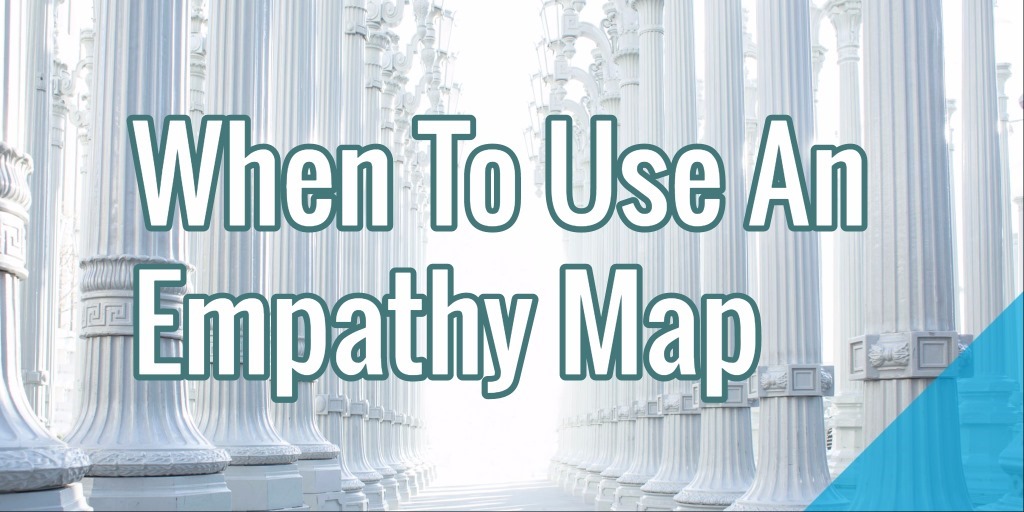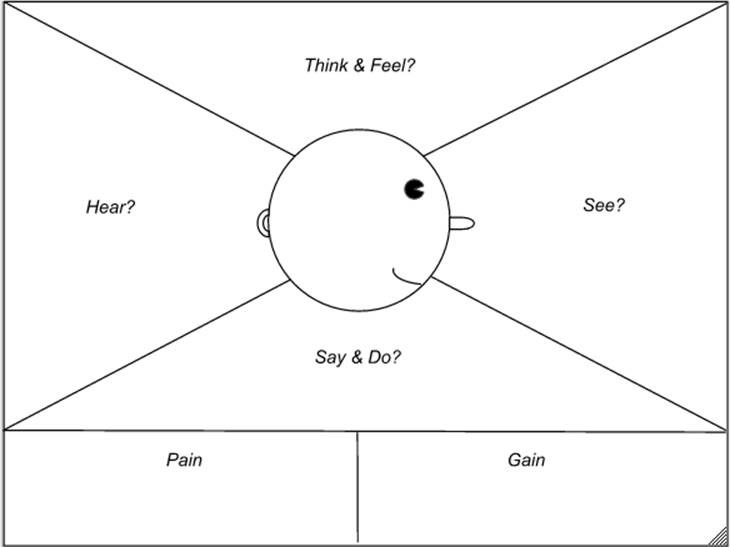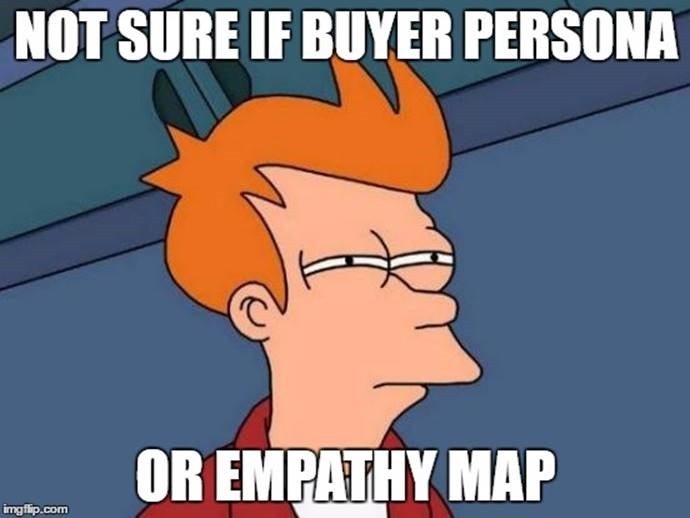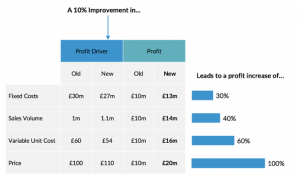
The Empathy Map is one of those tools that’s not only useful to almost every department in a company, but which is also free. You can either draw it yourself, or use an online template – the latter’s especially useful for teams that work remotely and need a common ground for communication and planning.
What’s an empathy map, you say?
This is how it looks:
 Source: Solutions IQ
Source: Solutions IQ
The empathy map was developed by XPLANE’s founder David Gray and used when consulting for clients. The map is meant to help stakeholders increase or create empathy for your customers or users. It allows participants in this exercise to get into the mind of their target audience and understand what they think and feel, what they do, what they need, and so on.
The stakeholders can be any member of a company: developers, designers, customer support reps, marketers, and so on. It basically depends on the nature and structure of your company.
If you’re reading this, you probably already know what an empathy map is and are looking for the best situations to apply it.
Some Resources Before We Move On
The benefits of designing products or services with empathy at the forefront of design are well argued in this paper conducted by Deana McDonagh and Joyce Thomas. It’s well worth a read, and will explain the benefits of empathic research better than any other articles on the topic, and clarify why it might help you end up with a great product.
What’s a great product?
According to the authors, a great product:
- Adds value
- Encourages people to use it consistently
- Avoids misuse or abandon through good design
- Addresses a clear problem and is a solution
In case you need a bit more explaining on how to use an empathy map and run a session or workshop around it within your team or company, I recommend this Copyblogger article. You can also check out this post which has a neat section on how an empathy mapping session can be run.
You can even create your own custom empathy map using this template from Conceptboard, and adapt it to your specific needs and goals. It’s free to use, highly adaptable, and can be shared with anyone you see fit. It’s ideal for teams that work remotely but need to keep their users in mind.
Who Should Participate?
The short answer is: everyone.
The long answer: it depends on the end goal.
If you’re developing a business model, you want developers, customer support, marketing, designers, and everyone who will ultimately have a say in the production and promotion of the product/service. If the goal is narrower, so can be the choice of participants. Think about who will use the empathy map, and invite them to the workshop.
When You Should Use An Empathy Map
At a first glance, an empathy map is very similar to creating customer personas. But they really just overlap on some aspects. An empathy map goes beyond the interests, skills, or lifestyle of your customers, and into what they see, feel and think – allowing you to gain a deeper understanding of what it’s like to be them.
It allows you to empathize with the user or customer, hence the name. And you can use it to empathize with your ideal customer, or with the various segments of your audience. It all depends on the scope.

Sometimes, the empathy map is used way after your target personas have been defined. And the map has a slight advantage – it’s visual, and can (should!) stay on display permanently, where developers, engineers, designers, marketers or customer support reps can see it every day.
It’s also fluid and flexible, so invite everyone to add to it as new information and data gather, as you gain more and more insight into who your customer is.
And you don’t require any special training to use it. You’ll notice it’s very intuitive, and all that’s needed is input from the people who’ll be referring to it later on.
So here’s a few of the most important situations where using the empathy map will help you reach your goals:
1. Business Model Design
You can start off to great advantage if you use the empathy map to help design your business model. Some of the most successful businesses today are customer-centric, or making the move towards it..
Using an empathy map when defining the infrastructure of your business model means researching who your ideal customer is, what they need, what their pain points are, and how you could provide a solution to an existing problem they have. This will allow you to decide how your business will be run. Whether you’ll be developing products or offering services, the empathy map will inform all your decisions. And when you build with the customer in mind, you can rest assured that you’ll meet, and exceed their expectations.
It’s true, however, that few businesses start off with enough resources to invest in consumer research. But the good thing about an empathy map is you don’t need to use a lot of real data to populate it. It’s enough to gather a team with all those involved, and ask everyone to give their feedback on what they think the consumer’s needs are, on what they think and feel, what expectations they have, and so on. The map is pretty clear in taking you through all the steps to be completed.
Moreover, you don’t need to start with a lot of statistical data in order to take informed decisions. You can conduct your own small scale research by directly contacting people who already use products similar to yours, or who would be the target of such a product/service once you create it. Their feedback should be enough to get you started.
At this stage of design, the empathy map will help you define your future course and strategies much better, keeping them aligned to a clear goal and, perhaps more importantly, towards someone you’re getting to know.
It gets everyone used to thinking about the customer in everything they do, and thus better equipped to create an outstanding product or an excellent service.
2. Product Development
Similarly, an empathy map can be effective when you’re creating a new product in order to help developers/engineers/creators empathize with those who will actually use your product.
Ideally, you’ll always do this when starting product development, and continue to use it as the product evolves, as you add to it. The empathy map will become more and more valuable as you start getting feedback from actual users.
An important thing to have in mind here is that not all the departments in your company have direct contact with your user/consumer/buyer. On a software product, for instance, developers will have the best of intentions – but it’s almost impossible for them to know and think of all the needs of the user. Sometimes they’ll get so involved with the how, that they’ll lose sight of the why.
That’s what the empathy map is for. It reminds them that a real person will be using that product, that not all people think the same way, or take the same routes when using a product, and even that people will have slightly different expectations of the product.
3. Customer Profiles
Although this is usually a part of persona development, the empathy map can be used to help team members add even more depth to those personas and bring them closer to resembling real human beings. This process can help reveal things about the personas that normal procedures wouldn’t have.
In any stage of your business (business model development, product development, beta release, product expansion, etc.), your customer profiles will guide you through what needs to be done. And constantly adding to these profiles is just as important.
It would be very difficult, if not impossible, to improve an existing product or service without consumer feedback.
You’ll often find it’s not enough to think in terms of: “the product’s users have this particular job to do, they want to get this done, their difficulties are these, and the product helps them like that.” You need to go deeper, and try to understand who they are beyond the problem you’re trying to solve. And why, precisely, they need a (better) solution to their problem.
So you can add all these little details about each persona – this is the fun part, where everyone can use their imagination to pitch in and, with each new detail added, make it up into a likeable character, or just someone that feels real.
Here’s a few sample questions:
- What’s the name of each customer persona?
- Do they have a nickname, or some way they “prefer” to be called?
- What’s a day like in the life of your user?
- What worries do they have?
- Do they have any children, or pets?
- Do they live in a house, or an apartment? Owned, or rented?
- What kind of car would they drive? Perhaps they prefer biking to work?
- What’s their clothing style?
- What music do they listen to?
- Do they enjoy sports, or prefer reading? Both?
This is all part of building an empathy map. And the questions (together with their answers) can be as diverse as possible, depending on their relevance to your goal. Try to add the kind of details that provide an insight into why they would need the product/service you want to create, or have created, that explain how and when they’d use it, their and their peers’ reactions to it, and so on.
At this point it matters less how much you rely on actual data about actual users or prospects. Use your imagination to infuse your personas with depth, with real personality traits, quirks, humor – and whatever other details help you empathize. Perhaps you’d even like to assign them a small anecdote or defining story.
That’s why it’s important that everyone in the team participate in the empathy map workshop. They will feel more invested, not only in the project itself, but in pleasing the persona they’ve helped create.
4. Staff Training
While creating and populating empathy maps is very useful for employees of a company or members of a team to get into the user’s skin, they can be just as important when adding new team members to your company.
Training them into empathizing with the customer is all the more essential when they’re part of a department that has direct contact with them, such as customer support and sales.
Customer support is one of the most important departments in a company, because they’re often responsible for how a customer/user perceives your company and your product or service. If team members here are not trained to empathize with the people who ask for help, with their problems and frustrations, it might lead to real issues in how your company is perceived.
It can be easy to dehumanize the user when you’re actually dealing with dozens, or hundreds of them every day, each of them with their own minor dissatisfaction. So customer support members need to be trained into visualising there’s a human on the other end of the line, a person with real problems and worries who sent that email.
This is actually one of the reasons why not everyone is suited for a customer support position. They might have an excellent understanding of the company product, services, or policies, but if they can’t empathize with a stranger and their problems and frustrations, they’ll never be able to solve them, nor to be a good representative of your company.
5. UI And UX Sessions
This is the type of empathy map workshop session whose end result will help designers and developers, but where people from all departments should contribute.
You already know how important the customer support team is in your company. But this is another situation where their knowledge of users/consumers is vital. They can bring relevant user feedback to the table, and introduce problems that others are not aware of, and could not be aware of from their positions.
In case you’re just starting product development and have no customer feedback to rely on, it’s still useful to bring in people from other departments, to help designers and developers with their own perspectives on ease of use, straightforwardness, appearance, and even details like colors, language used.
This not only keeps everyone informed on what goes on in the company, but strengthens team bonds, and helps make everyone feel like they’re contributing and their ideas are heard. And, in the end, helps create a product that users will love – that offers them real value, that meets their needs, that solves problems, and that is easy to use.
Useful feedback can come from the most unexpected places. If you’re really looking for ease of use, for a product that’s easy to approach by even the least trained user, then you can ask anyone for feedback.
6. Online Marketing And Sales Campaigns
Basically everything that a company does has to be informed by consumer data. It has to be done with consumers in mind. Your brand and reputation are created and supported by forming a relationship with your audience and meeting their expectations.
Marketing and sales need to address their real, relevant audience.
Using an empathy map, marketers and sales reps can understand who they’re addressing. Knowing the pain points of their prospective or ideal customers helps them use the right language, the kind of tone that appeals to the audience, and formulate offers that appeal to these prospects.
Here, too, using details that are not necessarily steeped in data can be extremely useful. The simple process of humanizing the customer helps marketers empathize and get into the right mindset.
Moreover, empathy mapping may lead to the discovery of new audience segments that could be targeted with the product or services. Untapped markets that are less obvious, or that were not part of the initial development of the product.
7. Understand User Behavior
When you’ve launched a new product and are measuring its impact in terms of usage, adoption, and possible improvements, one of your tasks is finding out how users behave.
Are they using your product the way you intended it to? If not, what are the causes?
Have they found new, different uses besides the ones that were part of your design? Or is it an UI/UX issue that causes them to skip steps, take shortcuts, or completely ignore certain attributes, characteristics, or functionalities of the product?
Empathy mapping allows you to get into the mind of your users and consumers. It allows you to look at your product with fresh eyes. What are they seeing and thinking when they use the product? What do they hear from their peers, or others using the product? Is there anything about the UI that prevents them from using the product as intended, or is it that they’re simply not interested in some of the functionalities?
The last thing you want is a product with a lot of dead weight, that’s been developed horizontally and not vertically, in depth. Here is where we go back to extreme users. More often than not, you’re much better off with a product that does one thing, but does it excellently, than with a product that does a whole bunch of things averagely or poorly.
So empathy mapping, which is designed to help you get into the mind of your users deeper than consumer personas, will help you understand why users behave a certain way when using your product or service.
8. Innovating Products And Services Through Extreme User Personas
Another interesting, and perhaps less common use for empathy maps is creating profiles of extreme users.
Every product or service has extreme users. They’re those (perhaps few) people who are almost addicted with your product. They use it daily, they know all its ins and outs, and are so dedicated to it that they might even find new uses for it altogether. I mean, who else would think of barbecuing with Coca-Cola?
But an extreme user can also be someone who doesn’t exactly use your product. They use an alternative, perhaps a “homemade” one.
An interesting example I came across is of a smartphone company looking to innovate or improve their products by talking to a professional mountaineer whose sponsors wanted him to take great shots at mountain summits that would obviously include the products they sponsored him with. This presented the mountaineer with the problem of finding a smartphone that weighed very little (they have to count every ounce they carry), that had a great camera, and whose battery lasted as long as possible.
It is true, however, that you must go very niche when thinking like this. If you have, or want to create a breakthrough, innovative product, think of someone who might need to use it all day long, every day. Someone whose job implies that they use your product constantly. Or who have found that such a product makes their job easier, but could be well helped by an improved version of it, or even something designed with specific needs in mind.
And this is where the empathy map fits in. In order to create the “extreme” version of your product, you need to get into the mindset of an extreme user. What do they think and feel? What do they see, what is their environment? What do they hear, and what are people around them saying? What are their pain points (and how could the product solve them)?
Now your turn!
Empathy maps have a lot of room in your company. You can introduce them in various stages of running your business, and the sooner you start, the better.
Since they apply so well to business model design, you can use them right at the offset. Then keep improving and tweaking them, adding details as you gain more contact with your users and prospective customers, as you get feedback and insights from them and the members of your company.
This will help you be the customer-centric business that customers will love to transact with, because it makes them feel like your product/service was created especially for them.
If you ever used an empathy map before, I’d love to hear about it. Where did you find it most useful, and where would you apply it next?
Let me know!
* Adapted lead image: ![]() Public Domain, pixabay.com via getstencil.com
Public Domain, pixabay.com via getstencil.com
The post When To Use An Empathy Map appeared first on Search Engine People Blog.
Search Engine People Blog(133)







